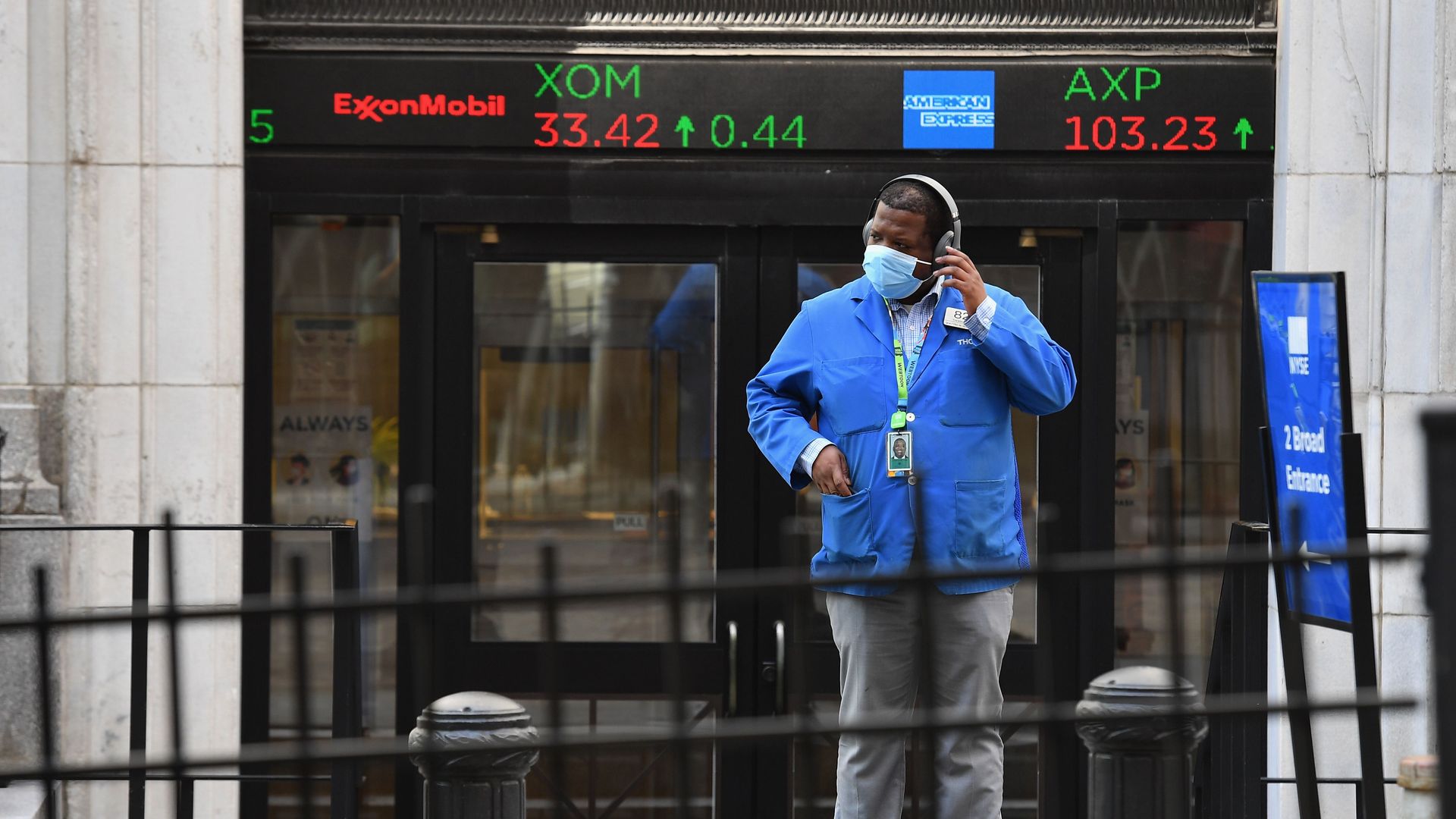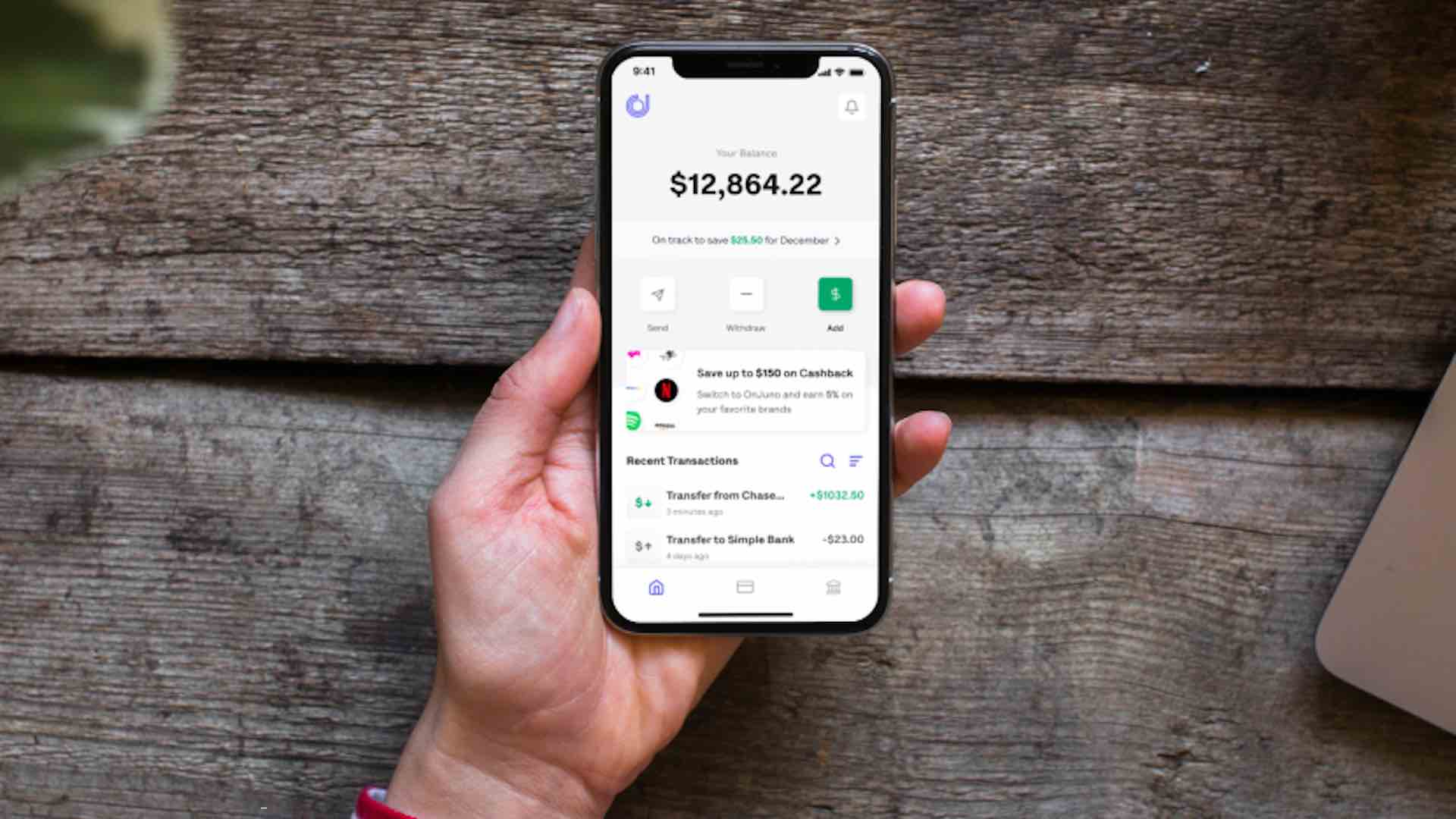| | | | | | | Presented By OnJuno | | | | Axios Markets | | By Dion Rabouin ·Feb 02, 2021 | | Happy Tuesday! Was this email forwarded to you? Sign up here. (Today's Smart Brevity count: 932 words, 3½ minutes.) 🚨Situational awareness: Alphabet, Amazon and Alibaba will all report earnings today, as will ExxonMobil and ConocoPhillips. 🎵 Trivia: The alleged final resting place of the Ark of the Covenant and the Queen of Sheba, this ancient kingdom that rivaled Rome during the 2nd and 3rd centuries was a trading juggernaut whose gold and ivory made it a vital link between ancient Europe and the Far East. | | | | | | 1 big thing: Traders return to buy the dip |  | | | Stock trader checks his headphones outside the NYSE. Photo: Angela Weiss/AFP via Getty Images | | | | Stock indexes around the globe bounced back on Monday as traders bought the dip in equities following last week's market drubbing. Why it matters: With hedge funds selling out of top tech names and volatility spiking up, there had been worry that the market's bull run could be in danger. Monday's price action showed there are still a contingent of bullish traders willing to bargain hunt after stocks fall. What happened: Major U.S. stock indexes had their worst weekly decline since October last week, with the S&P 500 down more than 3% from its January all-time high and the Nasdaq down more than 4% from its most recent record high. - On Monday, the S&P 500 jumped by 1.6% and the Nasdaq rose by 2.5%.
- Major indexes in Europe, Latin America, Africa and Asia also saw solid gains, with the MSCI All-Country World index, which tracks major stock markets in nearly 50 countries, jumping by 1.65% after falling in three of the previous four sessions.
What they're saying: Investors are still largely wearing rose-colored glasses as they look out at the U.S. economy, despite weakness in the U.S. job market and the slow vaccine rollout thus far. - "We're seeing the resiliency of the market," Craig Fehr, investment strategist at Edward Jones, told the Canadian Press.
- "I think we are seeing a bit of the shock and awe settle out today or to start this week, relative to what we saw last week," Fehr said.
- But, the big picture is that the fundamentals remain strong and will likely continue for the rest of 2021, he added.
Where it stands: As earnings season rolls on, S&P 500 companies have posted surprisingly strong results. - So far, 82% of companies have reported a positive EPS surprise for the fourth quarter.
- If that rate holds, it will mark the second-highest percentage of positive EPS surprises since FactSet began tracking the metric in 2008.
Watch this space: The Cboe's volatility index, VIX, declined by 8.6% on Monday, dropping to 30.24. That's well below its levels from late in January — the index gained 45% during the month — but is still well above its levels from December. - Some investors expect volatility to edge down this week as many hedge funds have already reduced short positions on stocks that have attracted a tremendous amount of attention on the internet.
The bottom line: "There has always been, in financial markets, a desire on the part of investors to get rich quick and so you may still wind up with isolated incidents in which you wind up with volatile performance of certain assets," BlueBay Asset Management CIO Mark Dowding told WSJ. |     | | | | | | 2. Catch up quick | | President Biden called the army coup in Myanmar a direct assault on the country's transition to democracy and the rule of law, and the UN Security Council will meet on Tuesday to discuss the issue. (Reuters) As of Monday afternoon, 26.5 million Americans had received one or both doses of a COVID-19 vaccine, more Americans than have tested positive for the virus that has infected 26.3 million and killed 443,000. (Bloomberg) Robinhood raised an additional $2.4 billion from shareholders after a $1 billion cash raise last week, bringing the company's total cash infusion to $3.4 billion in a week, more than it had raised during the history of the company. (WSJ) Silver dealers are scrambling to find supplies for retail buyers. (Reuters) |     | | | | | | 3. IBM cuts back on blockchain |  | | | Illustration: Rebecca Zisser/Axios | | | | Zack Seward of CoinDesk writes for Axios: IBM has greatly scaled back its blockchain unit, sources tell CoinDesk's Ian Allison. Why it matters: There is perhaps no more visible a champion of "enterprise blockchain" than IBM. A company that once trotted out a slate of TV commercials on the promise of more efficient supply chains has now cut up to 90% of its blockchain headcount. Driving the news: "Blockchain, not bitcoin" seems to have aged poorly. While cryptocurrencies have surged in value in recent months, big-business attempts to put blockchain technology to work have been stricken by COVID-related cutbacks and anemic adoption. - Overall, Big Blue recently announced another year of declining revenues in 2020, with numbers worse than analysts expected.
- Regarding the reported blockchain cuts, an IBM spokesperson denied the claims and told CoinDesk, "We have shifted some resources but remain committed to the technology, blockchain ecosystem and services."
The big picture: There's a wide spectrum of attempts to apply blockchain technology to industry uses, with companies like R3 on one end running tightly controlled shared databases, and other players like ConsenSys and EY building on Ethereum's public chain, which is itself broadly used and relevant, per Allison. - But the challenges are cropping up in the middle, where IBM and others are trying to build tech that fuses some elements of both public and private blockchains.
|     | | | | | | A message from OnJuno | | Why you should ditch your savings account for OnJuno | | |  | | | OnJuno is a new checking account that earns you 2.15% on deposits and 5% cash back on top brands. Benefits Include: - Create an FDIC Insured checking account in just 5 minutes.
- No minimum balance, no overdraft fees, and no worries.
- Withdraw your money anytime, with no penalties or hidden fees.
Join Now. | | | | | | 4. CBO projects U.S. growth returns to pre-pandemic level this year |  Data: CBO; Note: Inflation (PCE price index) and GDP estimates show percent change from prior year, Unemployment shows estimated Q4 level; Chart: Axios Visuals Axios' Courtenay Brown writes: U.S. GDP will return to its pre-coronavirus level by mid-2021 — a quicker than expected recovery from the economy's pandemic free fall, according to new projections by the Congressional Budget office. Why it matters: The latest estimates from the nonpartisan office paint a rosier — though still not great — path for the U.S. economy. Details: The unemployment rate is estimated to hit 5.3% by year-end — versus the 7.6% the CBO estimated in July. (As of December, the unemployment rate was 6.7%.) - Longer-term, the CBO projects that the Federal Reserve's preferred inflation gauge will average 1.9% between 2024 and 2031 — slightly below the Fed's 2% inflation target.
- By a different gauge, the CBO sees inflation averaging 2.2% within that timeframe.
Yes, but: It will still be another three years before there are as many employed Americans as there were before the pandemic hit. Between the lines: The projections don't factor in the stimulus measures proposed by the Biden White House — and there are questions about whether these rosy forecasts could hurt the administration's case for additional stimulus. - The CBO said the $900 billion relief bill signed into law in December would boost the level of real GDP by 1.5% this year and next — though the bulk of the impact will happen in 2021.
|     | | | | | | A message from OnJuno | | It's time to ditch your savings account for OnJuno | | |  | | | OnJuno is a new checking account that earns you 2.15% on deposits and 5% cash back on top brands. Benefits Include: - Create an FDIC Insured checking account in just 5 minutes.
- No minimum balance, no overdraft fees, and no worries.
- Withdraw your money anytime, with no penalties or hidden fees.
Join Now. | | | | Thanks for reading! Trivia: The alleged final resting place of the Ark of the Covenant and the Queen of Sheba, this ancient kingdom that rivaled Rome during the 2nd and 3rd centuries was a trading juggernaut whose gold and ivory made it a vital link between ancient Europe and the Far East. Answer: The kingdom of Aksum (Axum) in present day Ethiopia and Eritrea. Its rulers were known as the kings of kings. | | | | Axios thanks our partners for supporting our newsletters.
Sponsorship has no influence on editorial content. Axios, 3100 Clarendon Blvd, Suite 1300, Arlington VA 22201 | | | You received this email because you signed up for newsletters from Axios.
Change your preferences or unsubscribe here. | | | Was this email forwarded to you?
Sign up now to get Axios in your inbox. | | | | Follow Axios on social media:    | | | | | |







No comments:
Post a Comment